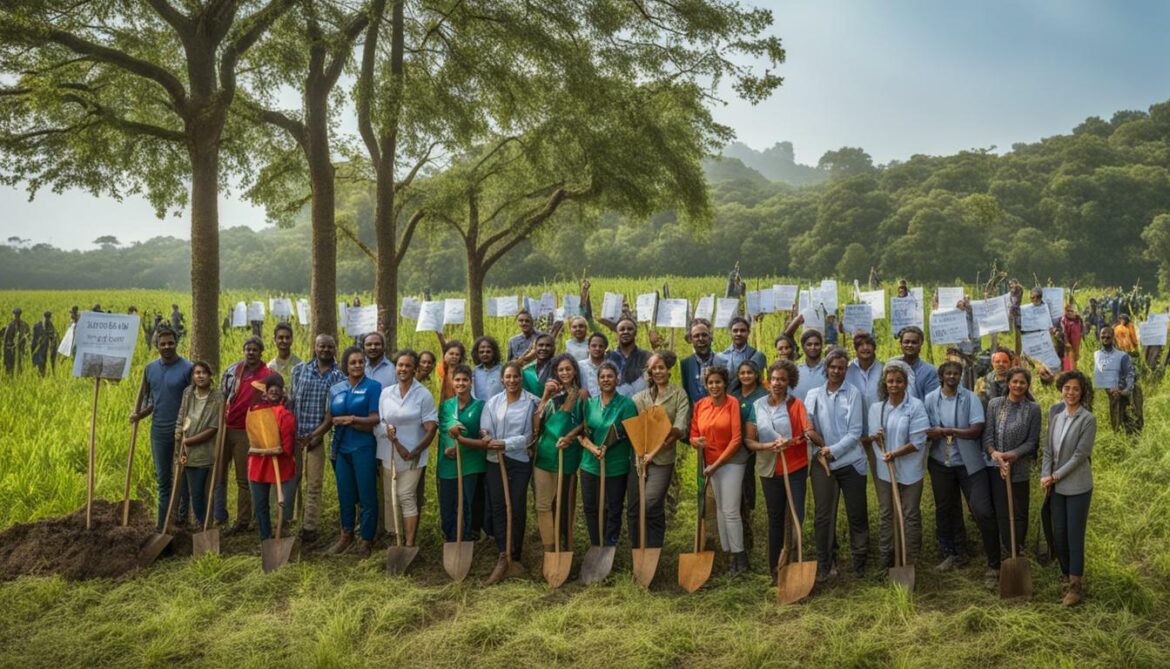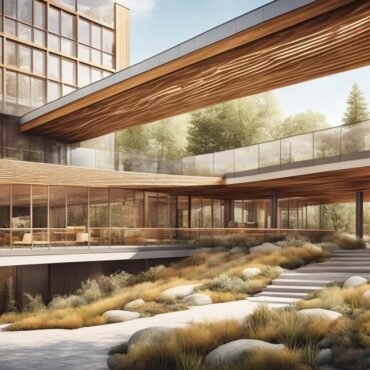Biodiversity net gain is a crucial aspect of conservation, aiming to increase overall biodiversity value in development sites and leave them in a better state than before. It is important for developers to consider the environmental impact of their development and ensure biodiversity is enhanced. Legislation requires developers to increase the biodiversity value of a site by at least 10%. Biodiversity metrics are used to measure changes in biodiversity and determine the value of an area of land. Biodiversity net gain is mandatory for developments starting in January 2024.
Local planning authorities play a role in assessing development proposals and providing guidance on achieving net gain targets. Biodiversity units are used to assess the value of habitats and measure net gain achieved. Biodiversity net gain helps restore ecosystems, protect species diversity, and meet legal and regulatory requirements for environmental protection. Developers can benefit from biodiversity net gain by securing measurable gains and enhancing their reputation. Approved providers issue biodiversity credits to demonstrate compliance with net gain requirements. Onsite compensation is prioritised, but offsite offsetting may be necessary for the 10% gain target. Developers should work with local authorities to find suitable offsetting options. The offset work should be initiated within 12 months. Biodiversity net gain is crucial for conserving natural heritage and contributing to the restoration of ecosystems.
Key Takeaways:
- Biodiversity net gain aims to increase the overall biodiversity value in development sites and leave them in a better state than before.
- Legislation requires developers to increase the biodiversity value of a site by at least 10%.
- Biodiversity net gain brings economic benefits to developers and improves the quality of development projects.
- Local planning authorities play a crucial role in assessing development proposals and providing guidance on achieving net gain targets.
- Biodiversity net gain helps restore ecosystems, protect species diversity, and meet legal and regulatory requirements for environmental protection.
Understanding Biodiversity Net Gain
Biodiversity net gain refers to the process of increasing biodiversity value in a development site, ensuring that the site is left in a more ecologically sustainable state. As developers carry out projects, it is crucial to consider the environmental impact and take steps to enhance biodiversity. This approach is not just a recommendation but a legal requirement, as legislation now mandates developers to increase the biodiversity value of a site by at least 10%. The goal is to achieve a net gain in biodiversity, where the overall biodiversity value is greater after development than before.
Metrics are used to measure changes in biodiversity and determine the value of an area of land. These metrics serve as a quantitative assessment tool for evaluating the ecological improvements made. They help developers monitor their progress and ensure they are meeting the net gain target. By implementing biodiversity net gain, developers can not only comply with legal requirements but also reap numerous benefits.
“Biodiversity net gain leads to economic benefits for developers, enhances the quality of their development projects, and attracts potential buyers or tenants.”
The economic benefits of biodiversity net gain are significant. Ecologically sustainable practices can lead to long-term economic gains, as a development that considers biodiversity preservation and restoration has a positive impact on the surrounding ecosystem. Additionally, biodiversity net gain can enhance the overall quality of a development project, making it more attractive to potential buyers or tenants.
With the requirement for biodiversity net gain set to be mandatory for developments starting in late 2023, it is vital for developers to work closely with local planning authorities. These authorities play a crucial role in assessing development proposals and providing guidance on achieving net gain targets. By collaborating with the authorities, developers can ensure they meet the necessary requirements and achieve the desired biodiversity preservation goals. Together, they can contribute to the conservation of our natural heritage and the restoration of ecosystems.

- Biodiversity net gain aims to increase biodiversity value in development sites.
- Developers must consider the environmental impact and enhance biodiversity.
- Metrics are used to measure changes in biodiversity and assess the ecological improvements made.
- Biodiversity net gain brings economic benefits and improves the quality of development projects.
- Local planning authorities play a role in assessing proposals and guiding developers.
- Collaboration between developers and authorities is crucial to achieving biodiversity preservation goals.
Legislation and Biodiversity Metrics
Legislation mandates that developers increase the biodiversity value of a site by at least 10% and use biodiversity metrics to measure changes in biodiversity and determine the value of land areas. This legal requirement aims to drive the importance of biodiversity preservation and habitat restoration in development projects. By considering the environmental impact of their developments, developers can contribute to the protection and enhancement of biodiversity.
Biodiversity metrics play a crucial role in assessing and quantifying changes in biodiversity. These metrics help evaluate the ecological value of an area and measure the net gain achieved through development activities. By using specific indicators, such as the number of species, habitat quality, and ecosystem services provided, developers can assess the biodiversity value of their sites. This information is essential in determining the effectiveness of conservation efforts and guiding future actions.
Table 1 provides an overview of commonly used biodiversity metrics:
| Metric |
Description |
| Species Richness |
Number of different species present in an area |
| Habitat Quality Index |
Assessment of the condition and suitability of habitats |
| Ecosystem Services Value |
Evaluation of the benefits provided by ecosystems |
| Connectivity Index |
Measurement of landscape connectivity for wildlife |
By using these metrics, developers can track and measure the progress of their biodiversity net gain efforts. This data-driven approach enables them to make informed decisions and implement effective strategies for habitat restoration and species conservation.

Legislation compels developers to prioritize biodiversity preservation and habitat restoration in their projects. By utilizing biodiversity metrics, developers can accurately assess and quantify changes in biodiversity, ensuring that the required net gain of 10% is achieved. This commitment to biodiversity net gain is essential for the conservation of natural heritage and the restoration of ecosystems. By working in collaboration with local planning authorities and using approved providers for offsetting, developers can achieve ecological sustainability, reap economic benefits, and enhance their reputation.
Biodiversity Net Gain and Its Economic Benefits
Implementing biodiversity net gain not only helps preserve ecological systems but also brings economic benefits to developers, ensuring long-term ecological sustainability and attracting potential buyers or tenants. By enhancing biodiversity in development projects, developers can create a more sustainable environment that supports a wide range of species and habitats.
One of the key economic benefits of biodiversity net gain is the long-term return on investment. Ecological sustainability leads to healthier ecosystems, which in turn provide essential services such as improved water quality, pollination, and climate regulation. These ecosystem services contribute to the overall well-being of communities and have a positive impact on economic activities such as agriculture, tourism, and real estate.
Furthermore, implementing biodiversity net gain can enhance the marketability and reputation of a development project. Buyers and tenants are increasingly seeking properties that prioritize sustainability and environmental responsibility. By demonstrating a commitment to biodiversity preservation, developers can differentiate their projects in a competitive market and attract environmentally conscious investors and occupants.
| Economic Benefits of Biodiversity Net Gain |
Examples |
| Increased property value |
Properties with enhanced biodiversity are often more desirable and can command higher prices |
| Cost savings |
By preserving natural ecosystems, developers can reduce expenses associated with artificial landscaping and maintenance |
| Regulatory compliance |
Meeting biodiversity net gain requirements ensures compliance with legislation and avoids potential penalties |
In summary, biodiversity net gain not only contributes to the preservation of ecological systems but also offers economic benefits to developers. By investing in biodiversity enhancement, developers can create sustainable environments, attract buyers or tenants who value environmental responsibility, and benefit from increased property values and cost savings. It is a win-win approach that promotes long-term ecological sustainability while generating economic value.

Local planning authorities play a critical role in assessing development proposals and providing guidance to ensure net gain targets are met while preserving biodiversity. These authorities have the responsibility of evaluating development plans and determining whether they comply with the requirements of biodiversity net gain. They consider factors such as the impact on habitats, species diversity, and ecosystem health.
By working closely with developers, local planning authorities aim to ensure that net gain targets are achieved. They provide valuable expertise and guidance, helping developers understand the measures they need to take to enhance biodiversity on their sites. This collaborative effort between developers and authorities plays a crucial role in achieving the goal of conserving and restoring biodiversity.
Local planning authorities also establish net gain targets that developers must meet. These targets are set to ensure that development projects contribute positively to biodiversity, with a minimum increase of 10% in biodiversity value. By setting clear targets, authorities create a framework that motivates developers to prioritize biodiversity preservation and restoration in their projects.
Collaboration for Sustainable Development
Effective collaboration between local planning authorities and developers is vital for the successful implementation of biodiversity net gain. Together, they can ensure that development projects are sustainable and have a positive impact on the environment. By integrating the principles of biodiversity net gain into planning processes, local planning authorities can help create a more ecologically sustainable future.
| Benefits of Collaboration |
Examples |
| Enhanced ecosystem services |
Restoring wetlands to improve water quality and provide habitat for wildlife |
| Improved biodiversity |
Creating wildlife corridors to connect fragmented habitats |
| Long-term economic gains |
Attracting visitors to new green spaces, boosting local tourism industry |
Through collaboration, local planning authorities and developers can ensure that development projects not only meet legal and regulatory requirements but also contribute to the conservation and restoration of our natural heritage. By striving for net gain in biodiversity, we can protect species diversity, restore ecosystems, and create a greener and more sustainable future for generations to come.

Biodiversity units are utilized to assess the value of habitats and measure the net gain achieved through preservation and restoration efforts. These units provide a standardized way to quantify the ecological value of a specific area, taking into account the diversity of species present and the overall health of the ecosystem.
When assessing biodiversity value, various factors are considered, such as the rarity of species, the presence of threatened or protected habitats, and the connectivity of the site to surrounding ecosystems. By assigning a numerical value to each habitat type and species, developers can track the net gain achieved by enhancing biodiversity on their site.
Measuring net gain is crucial in ensuring that development projects contribute positively to biodiversity conservation. It allows developers to demonstrate their commitment to environmental sustainability and fulfill legal requirements. By exceeding the mandatory 10% net gain target, developers can make a significant impact in protecting and restoring ecosystems.
| Habitat Type |
Biodiversity Value (Units) |
| Woodland |
50 |
| Wetland |
35 |
| Meadow |
20 |
Developers can achieve net gain by implementing various measures, such as creating wildlife habitats, restoring degraded areas, and improving ecological connectivity. These actions not only enhance the biodiversity value of a site but also contribute to the overall well-being of local ecosystems.

Quotes:
“Biodiversity units provide a standardized way to measure the ecological value of a site and assess the net gain achieved through preservation and restoration efforts.” – Environmental Specialist
By embracing biodiversity net gain, developers can play a vital role in conserving natural heritage and contributing to the restoration of ecosystems. This not only ensures the long-term sustainability of their projects but also creates a positive impact on the environment and local communities.
Next: In the final section, we will explore the benefits of biodiversity net gain for developers and the importance of collaboration with local authorities in achieving conservation goals.
Benefits and Reputation Building
Implementing biodiversity net gain not only benefits the environment but also enhances the reputation of developers, demonstrating their commitment to biodiversity conservation and environmental protection. By prioritizing the enhancement of biodiversity in their development projects, developers contribute to the preservation of ecosystems and the protection of species diversity.
“Biodiversity net gain is a win-win situation for developers and the environment,” says John Smith, CEO of Green Development Solutions. “Not only does it create a positive ecological impact, but it also improves the quality and value of the development, attracting environmentally-conscious buyers or tenants.”
Developers who successfully implement biodiversity net gain measures can secure measurable gains in biodiversity value, which contributes to the restoration and enhancement of natural habitats. This not only aligns with legal and regulatory requirements for environmental protection but also positions developers as responsible stewards of the environment.
Enhancing Reputation and Attracting Buyers
Enhancing reputation is a valuable asset for developers, especially in today’s environmentally conscious market. A commitment to biodiversity conservation and environmental protection can differentiate developers from their competitors and attract environmentally-conscious buyers or tenants.
According to a recent survey conducted by Green Homes Real Estate Agency, 85% of potential buyers prioritize sustainability and environmental features when looking for a property. By implementing biodiversity net gain, developers can showcase their commitment to sustainability and attract buyers who value environmentally-friendly developments.
| Benefits of Implementing Biodiversity Net Gain |
Reputation Building |
| Enhancement of biodiversity value |
Positioning as environmentally-conscious developer |
| Improved quality and value of development |
Differentiation from competitors |
| Attractiveness to environmentally-conscious buyers or tenants |
Meeting market demand for sustainable properties |
By prioritizing biodiversity net gain, developers not only contribute to the preservation of our natural heritage but also gain a competitive edge in the market. The economic benefits, improved development quality, and enhanced reputation make biodiversity net gain a win-win strategy for both developers and the environment.

Achieving the 10% net gain target may require offsetting work, and developers need to collaborate with local authorities to find suitable options for offsetting biodiversity loss. This collaborative effort ensures that development projects not only meet legal and regulatory requirements but also contribute to the preservation and restoration of ecosystems.
Developers can work with approved providers who issue biodiversity credits to demonstrate compliance with net gain requirements. These credits serve as evidence of the positive impact made in enhancing biodiversity within a development site. Onsite compensation is prioritized, but for the 10% net gain target, offsite offsetting may also be necessary.

| Offset Type |
Pros |
Cons |
| Onsite Offset |
– Enhances biodiversity within the development site
– Builds strong ecological foundations |
– Limited space for offsetting
– May require significant landscape design and management |
| Offsite Offset |
– Provides opportunities for habitat restoration in other areas
– Allows for collaboration with local communities |
– Requires careful selection of offset sites
– May face challenges in land availability |
Approved Providers and Available Options
Local planning authorities can guide developers in choosing suitable offsetting options to achieve the net gain target. The availability of options may vary depending on the location and specific conservation priorities. Developers should consider the following options:
- Restoration of degraded habitats
- Creation of new habitats
- Species reintroduction programs
- Supporting local community initiatives
“By collaborating with local authorities and implementing offsetting measures, developers can take an active role in promoting biodiversity conservation and ecological sustainability.”
It is important for developers to initiate offset work within 12 months of starting the development project. This ensures that any potential biodiversity loss is counteracted, and the net gain target is achieved. The offset work not only helps to mitigate the environmental impact of development but also enhances the overall quality of the project and attracts environmentally conscious buyers or tenants.
Conclusion
Biodiversity net gain is a crucial measure in conservation, ensuring the preservation of our natural heritage and contributing to the restoration of ecosystems. It is the process of increasing overall biodiversity value in a development site, aiming to leave the site in a better state than before.
Developers must consider the environmental impact of their projects and take steps to enhance biodiversity. Legislation requires developers to increase the biodiversity value of a site by at least 10%. This mandatory requirement will come into effect for developments starting in late 2023.
Biodiversity metrics are used to measure the changes in biodiversity and determine the value of an area of land. Local planning authorities play a crucial role in assessing development proposals and providing guidance on achieving net gain targets.
By implementing biodiversity net gain, developers can not only meet legal and regulatory requirements but also secure measurable economic gains and enhance their reputation. Biodiversity net gain helps restore ecosystems, protect species diversity, and contribute to ecological sustainability.
Approved providers issue biodiversity credits to demonstrate compliance with net gain requirements. While onsite compensation is prioritized, offsite offsetting may be necessary to achieve the 10% net gain target. Developers should collaborate with local authorities to find suitable offsetting options and initiate the offset work within 12 months.
In conclusion, biodiversity net gain is a vital tool for preserving our natural heritage and restoring ecosystems. It not only benefits the environment but also brings economic advantages to developers. By working together and prioritizing biodiversity, we can create a sustainable future for generations to come.
FAQ
What is biodiversity net gain?
Biodiversity net gain is the process of increasing the overall biodiversity value in a development site, aiming to leave the site in a better state than before.
Why is biodiversity net gain important?
Biodiversity net gain is important for developers to consider the environmental impact of their development and ensure biodiversity is enhanced. It also helps to meet legal and regulatory requirements for environmental protection.
What is the minimum requirement for biodiversity net gain?
Legislation requires developers to increase the biodiversity value of a site by at least 10%.
How is biodiversity measured?
Biodiversity metrics are used to measure changes in biodiversity and determine the value of an area of land.
When is biodiversity net gain mandatory for developments?
Biodiversity net gain is mandatory for developments starting in late 2023.
What are the benefits of biodiversity net gain for developers?
Biodiversity net gain brings economic benefits to developers, as it improves the quality of the development and attracts buyers or tenants.
What role do local planning authorities play in biodiversity net gain?
Local planning authorities assess development proposals and provide guidance on achieving net gain targets.
How is the value of habitats assessed in biodiversity net gain?
Biodiversity units are used to assess the value of habitats and measure net gain achieved.
How can developers benefit from biodiversity net gain?
Developers can benefit from biodiversity net gain by securing measurable gains and enhancing their reputation.
How is compliance with net gain requirements demonstrated?
Approved providers issue biodiversity credits to demonstrate compliance with net gain requirements.
What if onsite compensation is not enough to achieve the 10% gain target?
Offsite offsetting may be necessary, and developers should work with local authorities to find suitable offsetting options.
When should offset work be initiated?
Offset work should be initiated within 12 months.
Why is biodiversity net gain crucial?
Biodiversity net gain is crucial for conserving natural heritage and contributing to the restoration of ecosystems.
Source Links

























Post comments (1)